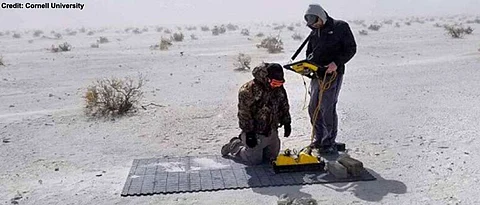

New York: Using a special type of radar, researchers have found the invisible footprints hiding since the end of the last ice age -- and what lies beneath them.
The fossilised footprints reveal a wealth of information about however humans and animals moved and interacted with each other 12,000 years ago, according to the study published in the journal Scientific Reports.
"We never thought to look under footprints, but it turns out that the sediment itself has a memory that records the effects of the animal's weight and momentum in a beautiful way," said study lead author Thomas Urban from Cornell University in the United State.
"It gives us a way to understand the biomechanics of extinct fauna that we never had before," Thomas Urban said.
The scientists examined the footprints of humans, mammoths and giant sloths in the White Sands National Monument in New Mexico.
Using ground-penetrating radar (GPR), they were able to resolve 96 % of the human tracks in the area under investigation, as well as all of the larger vertebrate tracks.
"But there are bigger implications than just this case study," Thomas Urban said.
"The technique could possibly be applied to numerous other fossilised footprint sites around the world, potentially including those of dinosaurs. We have already successfully tested the method more broadly at multiple locations within White Sands," Thomas Urban added.
"While these 'ghost' footprints can get invisible for a short time after rain and when conditions are just right, now, using geophysics methods, they can be recorded, traced and investigated in 3D to reveal Pleistocene animal and human interactions, history and mechanics in genuinely exciting new ways," said study co-author Sturt Manning.
Ground Penetrating Radar is a nondestructive techique that allows researchers to access hidden information without the need for excavation.
The sensor - a kind of antenna - is dragged over the surface, sending a radio wave into the ground. The signal that bounces back gives a picture of what's below the surface.
